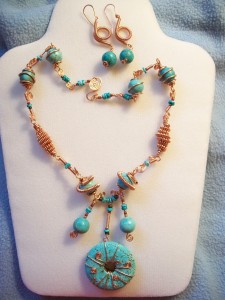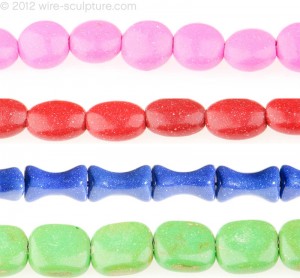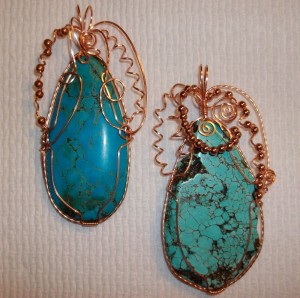- NEW DVD Series – Stone Setting with Bezels
- Tube Set Charm by Kim St. Jean
- Prong Basket Pendant by Kim St. Jean
- NEW DVD Series – Stone Setting with Cold Connections
- New DVD Series – Stone Setting with Wire
- NEW DVD Series: Introduction to Stone Setting by Kim St. Jean
- Featured Tool: Bracelet Bending Plier
- NEW Dvd by Eva Sherman
- Fun, Fast Fold Forming DVD Series
- Double Band Ear Cuff from Alex Simkin
Gem Profile Oct. 5: What is Magnesite?
by Rose Marion, Wire-Sculpture.com

Magnesite
Shop Magnesite Cabochons | Shop Magnesite Beads
Magnesite is magnesium carbonate and is naturally a whiteish color with brown or cream matrix (lines running through it). Some vendors have labeled magnesite as white buffalo turquoise or chalk turquoise, but magnesite isn’t related to turquoise at all – it doesn’t contain copper. (Note: some authentic turquoise is also called chalk turquoise – more on that in a later gem profile.)
As you can see from the lovely jewelry featured in this article, while magnesite is naturally fairly colorless, it takes a dye phenomenally well. Dyed magnesite is one of the most popluar ways to wear turquoise-looking jewelry at a fraction of the price. There’s nothing wrong with using dyed turquoise magnesite in your jewelry – just make sure your customer understands what they’re buying.
Magnesite may also be heat-treated – possibly to stabilize the dye? – but any magnesite jewelry material that has a turquoise color, or lime or pink as well, has been dyed. Magnesite that has been dyed often has a tiny amount of white dots on the surface.
In magnesite that is intended to imitate turquoise, some bead manufacturers may employ a "crazing" method. Remember the craze effect on your aunt’s teacups? Same idea: quickly heating and cooling the stones, possibly with dye, so that there’s even more "turquoise matrix" to appreciate. Again, there is nothing wrong with using treated magnesite, as long as all parties involved are aware!
Magnesite can be found all over the world, including the United States, Austria, and Brazil. It’s best used in pendants and earrings, and I’d recommend against using it in rings and bracelets that would be bumped often.
Natural magnesite is soluble in saltwater, so be sure not to wear your magnesite jewelry swimming! Magnesite is also fairly soft and scratchable, rating a 3.5 – 4.5 on Moh’s scale. This is softer than real turquoise, which has a hardness of 5-6. If your magnesite is dyed, to protect the color, it’s recommended you clean the jewelry with a cloth rather than dipping it in a cleaner or cleaning solution.
Metaphysically speaking, magnesite is prized for aiding in meditation. It is said to relax and soothe the mind, allowing a deeper experience. It is also said to open the heart chakra, help one to learn to love oneself, and raise self-esteem. A natural remedy for restless sleep is to place a piece of magnesite under your pillow – provided you don’t have the sensitivity of a princess…!

Linda Barton wrapped this turquoise magnesite stone in copper wire, and hung it on a necklace with copper and real turquoise beads.
Raw magnesite is often fluorescent - so if you go black-light bowling or to a fun Halloween party, this might be a fun jewelry piece to wear. However, before you make a special piece, test your magnesite under a black light, because the way that it’s been cabbed or finished may have altered how it fluoresces.
Just a reminder, Wire-Sculpture does not make any claim as to medical or beneficial properties of any of its stones.
Next Friday’s Gem Profile is on howlite. Have you made wire jewelry with Howlite beads or cabochons before? Dyed howlite counts! Send your howlite pictures to tips@wire-sculpture.com, and they could be featured!
Resources & Recommended Reading
- Magnesite on Wikipedia
- Magnesite on WebMineral
- Magnesite Healing Properties
- Magnesite on Mindat
- Turquoise on Wikipedia
Gem Profile by Rose Marion
Click to Receive Daily Tips by Email
























zoraida
October 5, 2012 at 2:42 pm
Very interesting information on Magnesite, so much I didn’t know. I’m sure a lot of this stone slips by as
“Turquoise”. As you mention there is nothing wrong with using it dyed in jewelry, I simply avoid it in that particular color because it masquerades as turquoise so well. I didn’t know it is is soluble in saltwater or that it is fluorescent in it’s raw state!!!
Nina Christen
October 6, 2012 at 5:54 pm
I also found this article on Magnesite very interesting. Using a dyed stone to represent a real gemstone is something I will not do
without informing the customer. Just recently I purchased some
Kiwi Sugilite. I went to Google and found that Kiwi
stone is actually Sesame Jasper. I see you have an article on Howelite coming up. This is another stone dyed to represent another gem. The dyed stones are popular and more cost effective to use. I realize this but am having trouble adjusting to the look alike stones. Keep giving us this valuable information.
Pingback: About Howlite | Jewelry Making Blog | Information | Education | Videos
kirsten Philadelphia
October 12, 2012 at 6:09 pm
i also use a lot of Magnesite (and sometimes Howlite) in dyed form.. BUT! i simply never buy it in colors that could easily be mistaken for Turquoise or Lapis (the two most counterfeited stones).
in purples, lavenders, pinks, and mixed colors it is extraordinary. my favorite is “tequila” which fades from yellow through peach into a rose…
the reason i do not buy any that can miic turquoise or lapis is that i know i always label things, but when i sell cabs or jewelry to someone who may one day pass it on or re sell it, i do not want someone to get fooled…. i know “Ambroid” often ends up in the market as “amber” when it gets re sold..